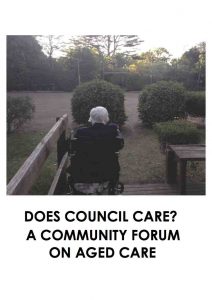Letter, The Australian
Andrew Burrell’s expose of the disgrace that is aged care residential assessment and accreditation is both excellent and long overdue (“Aged-care checks for neglect ‘failing’”, 29/4 – see below). What currently passes for assessment and accreditation in residential homes — whether in the for-profit, not-for-profit or church and community sectors — is a sorry joke.
As Burrell reports, billions of dollars of taxpayers’ money every year are finding their way into residential expansion projects, new administration offices and the like — but not into providing the improved standards of care, food, therapy and medical care that the elderly have a right to expect. The federal government’s policy failures in aged care accreditation are not new, and yet remain largely hidden from view. There’s a veneer of “process” about the existing apparatus — but it’s based on a “near enough is good enough” attitude.
Meanwhile, many elderly people are suffering — eating appalling food and enduring discomfort, even abuse, in residential homes around the country. Those homes doing a good job have nothing to fear from higher standards of assessment and accreditation. A “consumer-driven” model for aged care cannot absolve itself of the need to ensure standards are enforced and poor operators are forced out of the sector. It is the federal government itself that will, ultimately, pay a high price for its ineptitude and inexplicable inaction. One day, we will all be old, even aged care bureaucrats and their political masters.
John Simpson, Aged Care Matters
Aged care horrors: call for federal audit overhaul
The Australian 29th April 2017
Andrew Burrell
The federal agency that oversees aged-care centres has repeatedly failed to detect shocking cases of inadequate care and neglect, sparking calls for an overhaul of the “tick-a-box” accreditation system that is meant to ensure the safety of 170,000 nursing home residents.
Analysis by The Weekend Australian has uncovered examples of at least 10 aged-care homes that formally met all of the regulator’s 44 accreditation standards in recent years despite subsequent findings that they failed to provide a reasonable standard of care.
These include cases in which an 89-year-old war veteran was attacked by mice as he lay in his Queensland nursing home bed and another involving an elderly dementia sufferer who died after falling into a fountain in a Melbourne home’s courtyard.
In other incidents, a 79-year-old woman died from heat exposure after being locked out of a Melbourne home when the temperature hit 46.6C, and an 88-year-old woman in regional NSW died after contracting a urinary tract infection that was inadequately treated by her nursing home.
Only four of the nation’s 2678 nursing homes, or 0.14 per cent, had sanctions imposed and their funding frozen for failing to comply with standards.
Amid outrage in recent weeks over fresh revelations of abuse at the Oakden nursing home in Adelaide, aged-care advocates have called on the independent Australian Aged Care Quality Agency to be given tougher accreditation standards. They claim there are many more examples of abuse and neglect going unreported at homes that have been given a clean bill of health through the agency’s annual audits.
Advocates have also called for the introduction of staff-to-resident ratios in aged care, similar to those at childcare centres, hospitals and schools.
In the past two years, the agency has audited and approved at least three homes — including Ozanam Village in Queensland, Mitcham Residential Aged Care Facility in Adelaide and the infamous Oakden centre — shortly before revelations of serious problems.
The agency conducted 3380 audits last year, including an unannounced visit to every federally funded home at least once. Almost 100 per cent of homes received the tick of approval.
A former operations director with several companies in the sector, Mark Aitken, said he would encourage people not to place a family member in an aged-care home given weak regulation and poor standards in some centres.
“My advice to people is you need to do anything you can to keep your loved one out of a residential aged-care facility,” Mr Aitken said.
He said many homes were able to pass agency’s assessments because they received notice of visits from assessors several weeks in advance and were able to roster on additional staff and clean up.
“If you’re smart you can get around the system,” he said.
Aged-care researcher and former registered nurse Sarah Russell said accreditation was a “tick-a-box” system and the 44 standards included unclear phrases such as “adequate hydration and nutrition” and “continence management.
“They are worded in a way that is very vague and it’s very hard to measure against them,” Dr Russell said. “Continence management: what does that mean? Does it mean you put an old person in a nappy all day, or does it mean taking them to the toilet six times a day?”
Lynda Saltarelli, from lobby group Aged Care Crisis, said the horrors exposed at the Oakden centre in the past two weeks exposed the flaws in the accreditation system. She said the government was planning to introduce a truncated accreditation process but this would not improve standards.
Ms Saltarelli said the agency was “run for the industry rather than for community members”.
“Family members across Australia with a loved one in care can take no comfort whatsoever in the fact that nearly 100 per cent of aged-care homes across Australia are accredited by the (agency),” she said.
In the Senate next month, bureaucrats from the agency will be grilled about why the Oakden home was re-accredited last year. This follows the release of a report by South Australia’s chief psychiatrist, Aaron Groves, on April 20 that found residents — many of whom have dementia — were mistreated at the Makk and Macleay Nursing Home at Oakden.
Agency chief executive Nick Ryan said yesterday he had inspected the Makk and McLeay home this week and he was “very concerned” that Dr Groves’s report indicated that the problems were longstanding. “I am taking action to understand the findings of our re-accreditation audit from February last year that found the home complied with the accreditation standards,” Mr Ryan said.
An agency spokeswoman said it rarely refused to accredit or re-accredit a home.
“Where issues are identified at a home, the quality agency places the home on a timetable for improvement with clear expectations about improvements required for the home to maintain accreditation,” she said. “In most cases, homes take on what is needed and make improvements to ensure that standards are complied with.”
She said the agency had revoked the accreditation of 18 homes since 2000, but accreditation alone could not protect individuals.
Mr Ryan said in the agency’s most recent annual report that the consumers and their families “can be confident in the high level of care they are receiving”.
He was formerly chief executive of Leading Age Services Australia, the industry’s peak body.
Federal Aged Care Minister Ken Wyatt could not be reached for comment yesterday.

